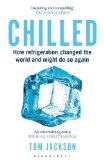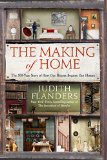Summary | Excerpt | Reading Guide | Reviews | Beyond the book | Read-Alikes | Genres & Themes | Author Bio

A History of How We Cook and Eat
by Bee WilsonI can never remember my grandmother without remembering the smoke-filled kitchen she worked in day in and day out. One of her best creations was rasam, the lentil broth soup that is the cornerstone of South Indian cooking. It wasn't until I tried my hand at recreating the dish in the heat of her kitchen that I realized what a precise science the dish was, even though grandma seemed to churn it out daily with such nonchalance.  The secret ingredient she swore by? A special pot called an eeya chombu, made with an alloy containing tin and other metals. My ninth grade self didn't realize that eeya chombu translated to "melting pot" - quite literally. Venturing into the kitchen one day while grandma was having a shower, I decided I would surprise her with a rasam of my own. I could do it. I had seen her make it many times, after all. But to my horror, as the soup gradually began to simmer and then violently boil over the untamed fire, the pot simply melted away. Not only had I lost my rasam but also my grandma's precious pot! Grandma, bless her soul, took in the scene of the crime with an extra dose of equanimity and Dad replaced the pot that very evening. All's well that ends well and my accident was forgiven and forgotten.
The secret ingredient she swore by? A special pot called an eeya chombu, made with an alloy containing tin and other metals. My ninth grade self didn't realize that eeya chombu translated to "melting pot" - quite literally. Venturing into the kitchen one day while grandma was having a shower, I decided I would surprise her with a rasam of my own. I could do it. I had seen her make it many times, after all. But to my horror, as the soup gradually began to simmer and then violently boil over the untamed fire, the pot simply melted away. Not only had I lost my rasam but also my grandma's precious pot! Grandma, bless her soul, took in the scene of the crime with an extra dose of equanimity and Dad replaced the pot that very evening. All's well that ends well and my accident was forgiven and forgotten.
It was that temperamental kitchen tool - my grandma's eeya chombu pot - that I was reminded of while reading Bee Wilson's fascinating historical account of the implements we use in working with one of humankind's most basic drivers - food. "A history of how we cook and eat," Consider the Fork is essentially a history of kitchen implements - from the most basic pots and pans, to spoons and chopsticks, knives, and even stoves and refrigerators. The chapters are divided by function: Heat, Grind, Cool, etc. and at the end of each chapter Wilson "profiles" an implement from that category. For example, the "Fire" chapter ends with a fun look at the classic toaster.
Wilson is a food journalist with a regular column for the Telegraph newspaper in the U.K. and her expertise shows. It is evident that she has conducted extensive research for the book but her engaging writing style couches its mountains of facts. For example, did you know that the term "curfew" was originally "a kitchen object: a large metal cover placed over the embers at night to contain the fire while people slept?" There are so many delicious facts worked into the book so smoothly that Consider the Fork is a treat to savor slowly. And since each chapter is not related to any other, you can also take it in bite-sized morsels. Along the way, we meet game-changers in the field like Carl Sontheimer, whose passion for quenelles lead to the invention of the Cuisinart; and Clarence Birdseye who developed flash-freezing as a way to freeze fresh vegetables.
Wilson is especially good at placing the history of these basic tools against the larger cultural backdrop in which they were invented. Food and culture are, after all, intrinsically linked. "For thousands of years, servants and slaves - or in lesser households, wives and daughters - were stuck with the same pestles and sieves, with few innovations. The technological stagnation reveals a harsh truth. There was very little interest in attempting to save labor when the labor in question was not your own," she writes. The Industrial Revolution brought about a sea change, not just in the production of goods or the labor needed to produce them, but also in individual kitchens "when altered patterns of labor combined with factories that could mass-produce low-cost metal gadgets finally led to an outpouring of new machines designed to make the cook's life easier."
My only beef with the book is that at times I wanted Wilson to linger, to tell us more. Each chapter felt more like good-sized appetizers than hearty, nourishing meals. It seemed almost as if Wilson was wary of cramming too much into each chapter so she stopped too early.
It is not just foodies who will love Consider the Fork, which is a fun and breezy read. At the very least, it will make you look at your pots and pans in a new light. And maybe even tempt you to give that bright-red Cuisinart on your countertop a whirl to create yet another memorable meal.
Arguably the best thing about Consider the Fork is that it never loses sight of the fact that for all the best kitchen implements in the world, the secret ingredient in every meal is still the person wielding the tool. I am reminded now that it wasn't my grandma's melting pot that made her rasam so memorable, it was her.
Picture of eeya chombu pot from eatomaniac.com
Additional Information
For a visual tour of the book, please visit my Pinterest board.
And If kitchen tools are one foundation of cooking, recipes and cookbooks must certainly be another. This review of The Cookbook Collector explores some old and rare cookbooks.
![]() This review was originally published in The BookBrowse Review in November 2012, and has been updated for the
October 2013 edition.
Click here to go to this issue.
This review was originally published in The BookBrowse Review in November 2012, and has been updated for the
October 2013 edition.
Click here to go to this issue.

If you liked Consider the Fork, try these:

by Tom Jackson
Published 2016
The refrigerator may seem mundane nowadays, but it is one of the wonders of twentieth-century science - lifesaver, food preserver, social liberator.

by Judith Flanders
Published 2016
The 500-year story of how, and why, our homes have come to be what they are, from the critically acclaimed New York Times bestselling author of The Invention of Murder and The Victorian City
Wisdom is the reward you get for a lifetime of listening when you'd rather have been talking
Click Here to find out who said this, as well as discovering other famous literary quotes!
Your guide toexceptional books
BookBrowse seeks out and recommends the best in contemporary fiction and nonfiction—books that not only engage and entertain but also deepen our understanding of ourselves and the world around us.